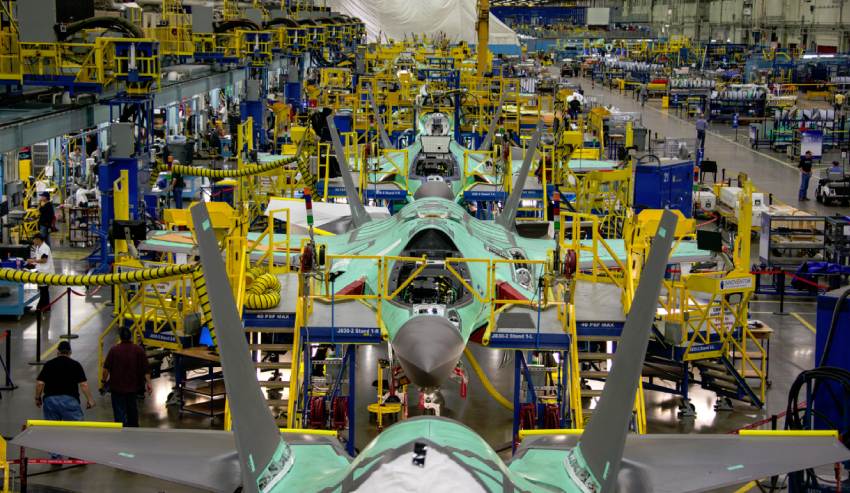Australian firms supplying components for the F-35 Lightning fighter aircraft stand head and shoulder above their peers and Lockheed Martin’s job would be much easier if there were more such firms in their supply chain, a senior Lockheed official says.
To continue reading the rest of this article, please log in.
Create free account to get unlimited news articles and more!
Steve Over, Lockheed Martin director of international business development, said the limit on more Australian firms joining the F-35 program came from the lack underlying aerospace industrial capacity.
“Without question the 15 companies that are supplying pieces and parts for F-35 are head and shoulders above their peers in our global supply chain,” he told Defence Connect in an interview in Fort Worth, Texas.
“If we could have more companies around the rest of the world that are as capable, as persistent, as tenacious and really be partners with us in trying to achieve our program level objectives, our lives would be much, much easier.”
Over named Marand, Heat Treatment Australia, Quickstep, BAE Systems Australia, Lovitt Technologies and Levett Engineering as examples of these fine Australian firms.
“The great thing for them is, they are building pieces not just for Australia’s 72 airplanes but for this program of record, which could easily grow to more than 4,000 aircraft,” he said.
“There are Australian parts on every F-35 that is delivered around the globe.”
Australia is committed to buying 72 F-35A aircraft, with two to arrive in Australia later this year. Australia could eventually acquire as many as 100.
Two jets were delivered in 2014 but remained at Luke US Air Force Base in the training pool for Australian, US and international pilots.
Over said this had been a big year for Australia, with seven aircraft delivered and the eighth within a week of ferrying from Fort Worth to Luke Air Force Base.
As at June, Australian aircraft, mostly the first two, had flown more than 1,000 sorties and more than 1,500 flight hours.
As production ramps up costs are going down. More than 200 are now in production in the Fort Worth facility, with 91 to be delivered in 2018.
There will be eight additional aircraft for Australia in 2019, then 15 in each of the next three years.
Over said cost reductions came from learning how to build the aircraft more efficiently.
“The other thing is scale – economic order quantity. The program is really ramping to full rate production. Last year we delivered 66 airplanes. This year we will deliver 91. In 2019 we will deliver 131 and by the time we get to 2020, we will be delivering something well in excess of 150 airplanes a year,” he said.
“That scale means we are able to negotiate with our supply chain to get the best prices.”
Over said another factor driving down costs was the proposed block buy. Rather than single yearly production contracts, lots 12, 13 and 14 will be aggregated into a single contract for 442 airplanes.
“That allows us to create certainty in the supply chain with all of our suppliers and to negotiate the best prices,” he said.
“We are mercilessly driving towards an airplane that delivered in 2020 will be a US$80 million F-35A.”
Over said he expected F-35 would be produced in similar numbers and for the same length of time as F-16, one of the world’s most successful fighters.
F-16 was supposed to be less than 1,000 aircraft for five air forces. Forty-four years on 29 nations have bought more than 4,600 F-16s.
For F-35, the current program is for 3,443 aircraft for the eight partner nations and the US. Over said he expected additional foreign military sales would take that to more than 4,000 aircraft produced beyond 2040.
“You are buying in at the early phases of an absolute cutting-edge, state-of-the-art piece of military technology that is decades ahead of adversary systems that are being fielded in the same timeframe,” he said.
“With continued investment and modernisation, this airplane will not only be relevant but well ahead of the threat for a generation to come which is exactly where you want to be,” he said.
Over said he wished there were more Australian companies in the F-35 supply chain.
“It’s not because we don’t want it, it’s because there is just not that much in the way of underlying aerospace industrial capacity in Australia,” he said.
Over said F-35 delivered fifth-generation capability to the Australian Defence Force but what that involved wasn’t widely understood.
He said there were four key discriminators, starting with stealth. F-35’s multi-spectral sensor suite existed on no other fighter in the world.
F-35 datalinks could communicate with other F-35s in a stealthy manner, sharing vast amounts of information.
Finally, F-35’s sensor fusion and computers automated all battlespace interpretation, creating a logical three-dimensional image for the pilot of every aspect of the battlespace.
“It is truly game changing technology,” he said.

 Login
Login







